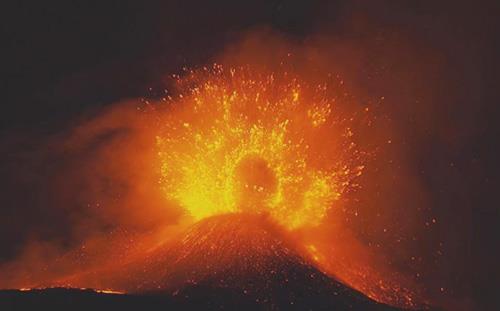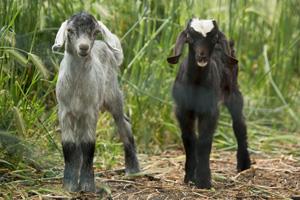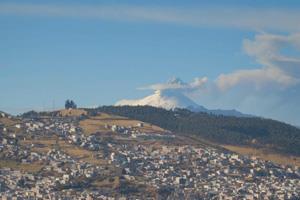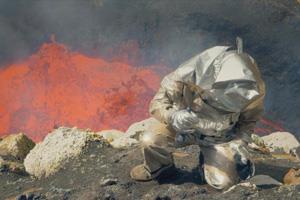
You could be forgiven if, asked how most of the victims in Pompeii died when Mt. Vesuvius erupted in AD 79, you replied that they were asphyxiated by ash and poisonous gas. Recent studies — in this decade — suggest most died instantly from extreme heat, though. They didn’t have time to suffocate.
You could also be forgiven for thinking that, once a volcano erupts, life vanishes forever. It’s hard to imagine anything surviving in the aftermath of such wanton destruction.
As the new PBS Nature program Living Volcanoes shows, though, in much the same way forest fires encourage new forest growth by returning dead trees and decaying plants to the soil in the form of nutrient-rich ash, life around volcanoes — both active and dormant — can be surprisingly rich.
 And not just the goats that have taken to browsing the slopes of Mt. Etna.
And not just the goats that have taken to browsing the slopes of Mt. Etna.
From Kilauea in Hawaii to Cotopaxi in Ecuador (below) to Vanuatu in the Melanesian Pacific (bottom), Living Volcanoes travels the far corners of the globe to show how resilient nature can be, even when it isn’t that easy to understand. Microorganisms that exist in an extreme environment aren’t easy to find, let alone study, but that’s exactly what some biologists are trying to do.
Why bother? Because, as German Research Center for Geosciences researcher Jens Kallmeyer shouts into his mouthpiece while flying a noisy helicopter over Marum Volcano on Ambrym Island in Vanuatu, the 200-foot wide lava lake is “a giant gateway to the planet’s beating heart.”
Figuring out what’s going on at the core of the planet we call home might help us figure out what’s happening around us in the real world of nature. What the scientists learn in volcanoes like Marum could change the way we think about the extremes of life on Earth, and might help us understand the likelihood of finding life elsewhere in our universe.
 Coincidentally, the veteran — but still viable — primetime reality-competition program Survivor begins a new season on CBS the same night Living Volcanoes makes its debut on PBS.
Coincidentally, the veteran — but still viable — primetime reality-competition program Survivor begins a new season on CBS the same night Living Volcanoes makes its debut on PBS.
And while there can be little doubt about which of the two is the more entertaining — and sexier — Living Volcanoes is on a whole other scale. It’s about real survival, measured in eons, not 39 days. Survivor has lasted close to 40 cycles so far, but the title of this latest edition — Survivor: Edge of Extinction — pales when, as Living Volcanoes’ reminds us, Mount Etna in Sicily (top) has been muttering and murmuring and blowing-up-real-good now for half-a-million years, give or take.
Mount Etna harbors clues as to what made planet Earth fit for life — life that includes immunity challenges, tribal councils, and Jeff Probst.
Here’s another thing you might not have guessed, judging solely from all the fire and brimstone that surrounds volcanoes: Volcanoes create water vapor, which condenses in the atmosphere and falls as rain. Not the black snow that has been falling recently in Siberian towns that lie adjacent to vast open-pit coal mines, but real, life-giving rain, of the kind that created the Earth’s oceans in the first place.
 “Every time a volcano erupts, it emits this life-giving gas,” Dr. Salvatore Giammanco of Italy’s National Institute of Geophysics and Volcanology explains, midway through the program. Volcanoes create a tear in the fabric of the Earth’s surface, allowing the water trapped beneath to escape as vapor.
“Every time a volcano erupts, it emits this life-giving gas,” Dr. Salvatore Giammanco of Italy’s National Institute of Geophysics and Volcanology explains, midway through the program. Volcanoes create a tear in the fabric of the Earth’s surface, allowing the water trapped beneath to escape as vapor.
That’s the theory, anyway, but as Living Volcanoes explains, it’s a theory that’s gaining credence in scientific circles with each passing day.
“Water that we see on Earth mostly comes from volcanoes,” Giammanco says. “Without volcanoes, there wouldn’t be life on Earth. Literally.”
The tribe has spoken.
Nature: Living Volcanoes premieres Wednesday, February 20, at 9 p.m. ET on PBS. Check your local listings.